
 The European Space Agency (ESA) is preparing for a November 20 launch of its “Gaia” space observatory, designed for a five-year mission to map and study one billion stars in the Milky Way Galaxy. Gaia will be launched from Europe’s spaceport in Kourou, French Guiana, on the South American coast.
The European Space Agency (ESA) is preparing for a November 20 launch of its “Gaia” space observatory, designed for a five-year mission to map and study one billion stars in the Milky Way Galaxy. Gaia will be launched from Europe’s spaceport in Kourou, French Guiana, on the South American coast.
Gaia’s main goal is to create a highly accurate 3D map of our Milky Way Galaxy by repeatedly observing a billion stars to determine their positions in space and their movement through it.
Other measurements will assess the vital physical properties of each star, including temperature, luminosity and composition. The resulting census will give astronomers an unprecedented new database for determining the origin and the evolution of our galaxy.
Gaia, named for the goddess of the Earth in Greek mythology, will map the stars from an orbit around the Sun, near a location some 600,000 miles beyond Earth’s orbit known as the L2 Lagrangian point. The gravitational forces at a Lagrangian point act to keep an object in a stable position relative to the Earth and Sun.
The spacecraft will spin slowly, sweeping its two telescopes across the entire sky and focusing their light simultaneously onto a single digital camera, the largest ever flown in space—it has nearly a billion pixels.
For the last two months Gaia has been rigorously tested in Kourou as part of the launch campaign. The Kouru site is particularly suitable as a location for a spaceport as it is quite close to the equator, so that the spinning earth can impart extra velocity to rockets as they are launched eastward.
“Getting ready for launch is an extremely busy phase for the mission teams, but it’s also extremely exciting and rewarding to see our mission so close to launch,” says Giuseppe Sarri, ESA’s Gaia project manager.
Earlier this month the spacecraft’s sunshield passed the final deployment test in the cleanroom in Kourou. It has now been stowed in its final configuration ready for the launch. Shortly after launch, the sunshield will be deployed, forming a 35-foot-wide “skirt” around Gaia’s base.
The shield has two purposes: to shade Gaia’s sensitive telescopes and cameras from sunlight, allowing them to cool to their operating temperature of -110°C, and to provide power to operate the spacecraft. The Sun-facing side of the shield is partially covered with solar panels to generate electricity.
“With this important milestone—and others—now completed, we are working through an intensive checklist of final activities that will culminate in the much-awaited launch of our ‘discovery machine’,” adds Sarri.
In the first week of November, the spacecraft will be mounted on the Soyuz launcher adapter and then integrated with the upper stage, which will eventually help boost Gaia onto its journey to L2. The Soyuz fairing—the nose cone that protects the sensitive spacecraft during the first four minutes of launch—will then be added.
On 15 November, Gaia will be moved to the launch pad for integration with the Soyuz launcher itself. Finally, the rocket will be fuelled. Gaia’s launch time is set for November 20 at 08:57:30 GMT, and will be streamed live on the ESA Portal at www.esa.int
“Our quest to create an enormous stellar census to solve questions on the origin, structure and evolutionary history of our home galaxy, and to discover tens of thousands of supernovas, previously unseen asteroids and even planets around nearby stars, is finally about to begin,” says Timo Prusti, ESA’s Gaia project scientist.


Be the first to comment